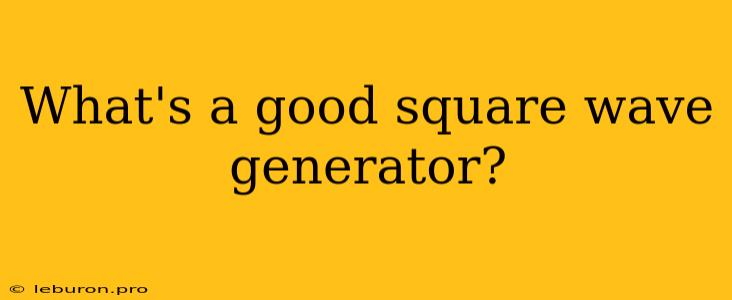What's a Good Square Wave Generator?
In the realm of electronics, the square wave, a periodic signal that alternates between two distinct voltage levels, is a ubiquitous waveform. Square waves find application in a vast array of circuits, including timers, oscillators, digital logic systems, and audio synthesis. Selecting the right square wave generator for your project can be a daunting task, given the plethora of options available. This article will explore the essential aspects to consider when searching for a good square wave generator, focusing on factors such as frequency range, accuracy, output characteristics, and specific applications.
Types of Square Wave Generators
Square wave generators can be broadly classified into analog and digital varieties, each with its own strengths and weaknesses.
Analog Square Wave Generators
Analog square wave generators typically employ operational amplifiers (op-amps) or comparators configured in an oscillator circuit. These circuits utilize the high gain and fast switching characteristics of op-amps to generate square waves. The frequency of oscillation is usually determined by external components such as resistors and capacitors, allowing for some degree of adjustment.
Advantages:
- Relatively simple design and construction.
- Cost-effective.
- Can achieve high frequencies, often in the MHz range.
Disadvantages:
- Susceptible to noise and drift due to component tolerances.
- May exhibit non-ideal square wave characteristics, such as rise and fall times and duty cycle variations.
Digital Square Wave Generators
Digital square wave generators are typically based on microcontrollers, integrated circuits (ICs), or dedicated square wave generator chips. These devices utilize internal timers or digital logic to generate precise square waves.
Advantages:
- High accuracy and precision.
- Wide frequency range, often reaching GHz frequencies in some ICs.
- Programmable frequency and duty cycle.
- Integrated features such as output buffers and pulse width modulation (PWM) capabilities.
Disadvantages:
- More complex design and implementation compared to analog circuits.
- Can be more expensive than analog counterparts.
Essential Considerations When Choosing a Square Wave Generator
When selecting a good square wave generator for your application, several key factors should be considered:
1. Frequency Range
The frequency range of the generator is crucial. It should encompass the frequencies required for your project. If you need a wide frequency range, a digital generator with programmability is often the better choice. For high-frequency applications, specialized ICs or dedicated square wave generator chips may be necessary.
2. Accuracy and Stability
The accuracy and stability of the generated square wave are vital for applications that require precise timing or signal integrity. Digital generators typically excel in this area due to their inherent accuracy and stability. Analog generators can be susceptible to noise and drift, leading to deviations in the waveform.
3. Output Characteristics
Consider the output characteristics of the generator, such as output voltage, current, and impedance. Ensure that the output specifications are compatible with your circuit requirements.
4. Duty Cycle
The duty cycle of a square wave refers to the percentage of time the signal is at its high level. Some generators offer adjustable duty cycles, allowing for fine-tuning of the waveform.
5. Applications
The specific application dictates the choice of a good square wave generator. For general-purpose tasks, a simple analog generator might suffice. However, for demanding applications like audio synthesis or digital logic circuits, a digital generator with advanced features may be preferable.
Popular Square Wave Generator Options
1. 555 Timer
The 555 timer is a versatile IC that can be configured to generate square waves. It is a popular choice for simple, low-frequency applications.
2. Dedicated Square Wave Generator ICs
Specialized square wave generator ICs, such as the XR2206 and the CD4047, offer a wide range of frequencies and programmable duty cycles.
3. Microcontrollers
Microcontrollers with built-in timers can be programmed to generate square waves. This provides flexibility and allows for complex waveform generation.
4. Function Generators
High-performance function generators can produce a variety of waveforms, including square waves. They offer precise frequency control, adjustable duty cycles, and advanced features.
Conclusion
Choosing the right square wave generator is paramount for achieving optimal performance in your project. By carefully considering the frequency range, accuracy, output characteristics, and specific application requirements, you can select a generator that meets your needs. Whether you opt for a simple analog solution or a sophisticated digital generator, ensuring the correct selection will contribute to a successful and reliable outcome.
